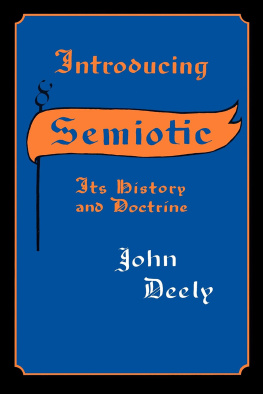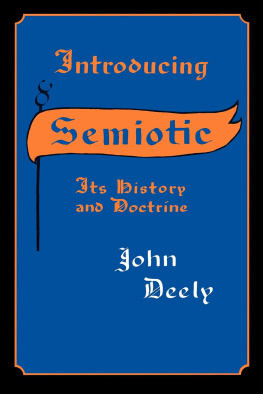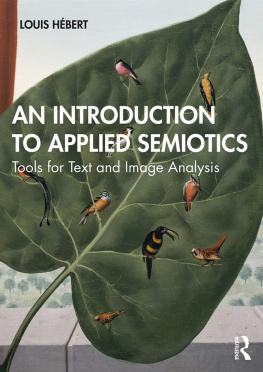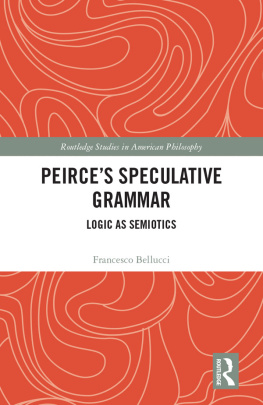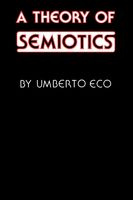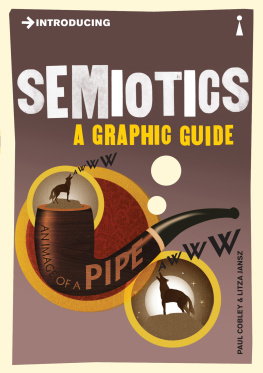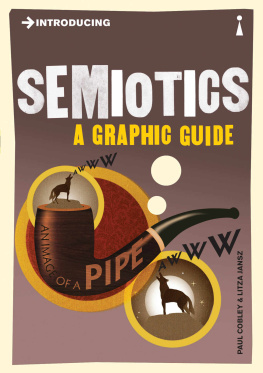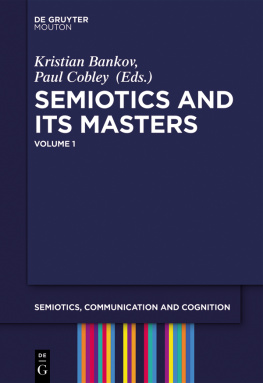
INTRODUCING SEMIOTIC
ADVANCES IN SEMIOTICS
General Editor, Thomas A. Sebeok

INTRODUCING SEMIOTIC
Its History and Doctrine
by
JOHN DEELY
with a Foreword by
Thomas A. Sebeok
INDIANA UNIVERSITY PRESS
BLOOMINGTON
Copyright 1982 by John N. Deely
All rights reserved
No part of this book may be reproduced or utilized in any form or by any means, electronic or mechanical, including photocopying and recording, or by any information storage and retrieval system, without permission in writing from the publisher. The Association of American University Presses Resolution on Permissions constitutes the only exception to this publication.
Manufactured in the United States of America
Library of Congress Cataloging in Publication Data
Deely, John
Introducing semiotic.
Bibliography: p. 205
Includes indexes.
1. Semiotics. I. Title.
P99.D4149.94682-47782
ISBN 13: 978-0-253-20287-1
According to the saying of Heraclitus
(Diels 1922: I, p. 100, Fragment 115),
to the soul belongs the lgos that increases itself,
this book is dedicated to
William Passarella
its sufficient and necessary condition
Paul Bouissac
its proximate cause
Professor Larry Crist
translator par excellence,
exemplar of practical semiosis
and to the memory of
Heinz Schmitz
(Ernst-R. Korn)
of the Little Brothers
26 January 1982
John Edward Sullivan
Ordinis Praedicatorum
15 September 192226 March 1981
student of Augustine,
who simply died too soon
ACKNOWLEDGMENTS
It was my intention in the writing of this book to make all acknowledgments by way of the dedication and appropriate comments distributed through the text and notes, particularly as my debts in the work have been extensive. Having pursued this design to the end, I yet find there is a remainder of debt that I have not been able to cover in this way, so I am adding here after all some separated lines of acknowledgment.
In writing the Section on Language for Part II, I profited in particular from remarks and suggestions of Dr. Dan Rogers and Dr. Ted Cruz, the latter a native Tagalog speaker and a living passage into the richness of our Latin heritage. In rethinking the whole matter of language and experience, the work of Donald Thomas in the Brookline schools has always afforded me a kind of generalized inspiration that has been of the utmost value.
A cover design expressly integrating the nature and history of the work covered is thanks to the refined artistic sensibilities and pre-eminently semiotic consciousness of Brooke Williams, who also lent her hand to matters of style and proofreading. The most indispensable single proofreader was my student Felicia Kruse, who also undertook the greater part of the indexing of the volume, and no small part of the bibliographical labor. A third proofreader, particularly helpful with Greek passages, was Dr. Jeffrey Buller, an excellent classicist and valued colleague. It is customary for an author to discharge those who assist from all responsibility for errors in a volume, but in this case, conceptual matter apart, I am happy to leave all responsibility for errors in final proof to these three excellent workers.
Finally, I must thank Mr. Bud MacFarlane and Ms. Marcie Bowman of Composition Specialists in Dubuque, Iowa, for their many hours of patient professional assistance in the design and layout of the book.
CONTENTS
by Thomas A. Sebeok
LIST OF DIAGRAMS
Foreword
What is truth? said jesting Pilate; and would not stay for an answer.
The idea of a general science of signs is rooted in fallacy, said inscrutably Scruton; yet could not penetrate to the bedrock that undergirds the pair of contemporary treatises that fell under his hand.
It is this infrastructure of fundamental semiotic principles that Deelys extended yet masterfully compacted and solidified survey aims to introduce and interpret in the first part of this book. He argues for and, I think, authenticates the essential confluence of logic and semiotic, and convincingly shows how one invents and keeps reformulating the other in many imaginative if reticular ways.
Although we tend to associate this assimilation primarily with Peirce, Deely reveals the idea in the very earliest doctrinal blueprints of our Greco-Roman precursors and sketches out the location of major forks in the ensuing road. His scholarship gives evidence that the ancient paths converge and culminate in one unified disposition of the doctrine of signs in the fourth decade of the 17th century, in the work of the Iberian philosopher, Poinsot. His Tractatus de Signis, which may well be, in Deelys words, the first systematic semiotic treatise in all the detail of its subtle and far-reaching exposition, had hitherto been known only to a privileged few, such as Jacques Maritain and Jos G. Herculano de Carvalho, through whose respective lectures and essays I had also come across his spoor. But Deely is the first to trace over the entire history of logic a mainstream of semiotic discourse, and to show how Poinsots thought, soon to appear in a great modern bilingual edition, belongs decisively to that mainstream as the missing link between the ancients and the moderns in the history of semiotic, a pivot as well as a divide between two huge intellective landscapes the ecology of neither of which could be fully appreciated prior to this major publishing event.
After Poinsot, Deely rapidly carries us back to the far more familiar highroad that leads, with some deviations and a few reasonable detours (notably in the area of induction), directly from Locke to Peirce.
What about semiotic inquiry in the 20th century? It is to this that Deely addresses the second part of this book, suggesting fundamental realignments in accustomed approaches to basic questions of human experience. Here he proposes some novel considerationsnotice, for example, the reversed order of what one would expect in the titles for the sections for this partwhich may well prove seminal for developments yet to come.
Taking the situation as a whole, it appears to me that there are two trails in view. One track leads outward into the general culture, widening to become the grand boulevard of semiotic influence, with incursions into all the humanities and social sciences, law and medicine, the multiform arts, the life science in general, the participatory universe of quantum theory, and, of course, as Deely is especially concerned to indicate, deeply penetrating into the very fabric of both modern and traditional philosophy. (In this territory, surely, lies the transcendent answer to Quines deceptively artless question: What Is It All About?) The other is the inward-turning, all but subterranean byway traveled by a handful of specialist practitioners of the doctrina signorum for its own sake. The objective of a sound education should be to instigate travel along both routes that of the Signs of the Universe, and that of the Universe of Signs the quaesitum for which Deelys contribution will be found indispensable.
Thomas A. Sebeok
National Humanities Center and Indiana University
Preface
This book had its origins in an evening lecture entitled The Relation of Logic to Semiotics, given as part of the first annual Summer Institute for Semiotic and Structural Studies, held at Victoria College of the University of Toronto in June of 1980. (General reviews of this Institute can be found in Herzfeld 1981 and Deely 1981a.) Response to the lecture was such that it was subsequently published as an article in the journal of the International Association for Semiotic Studies,
Next page
